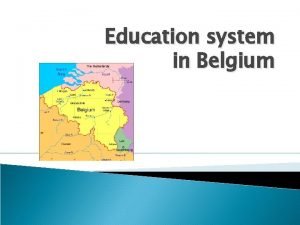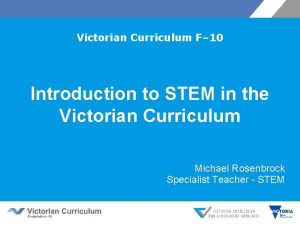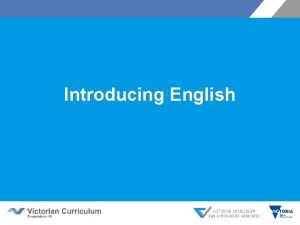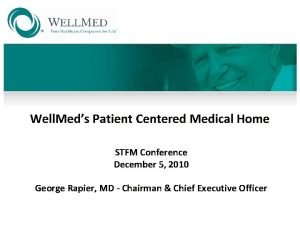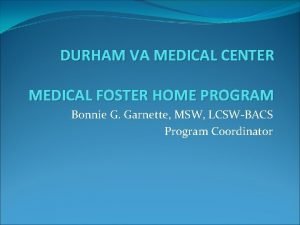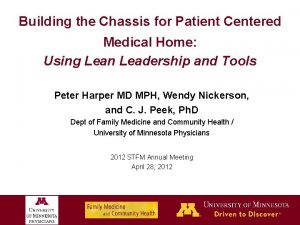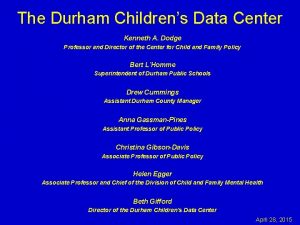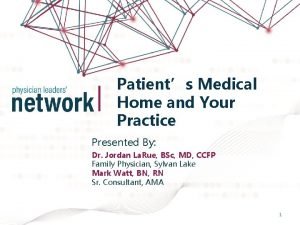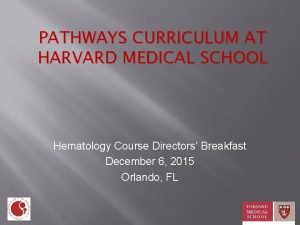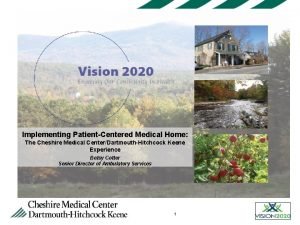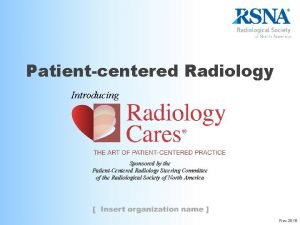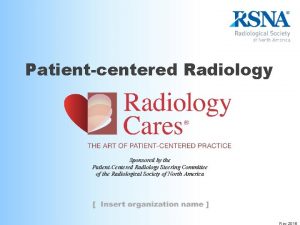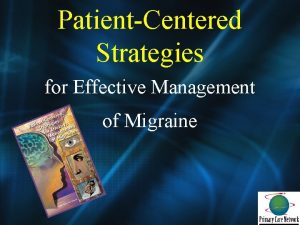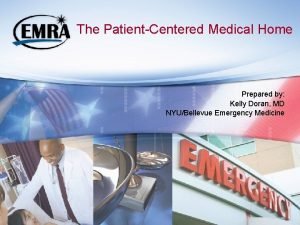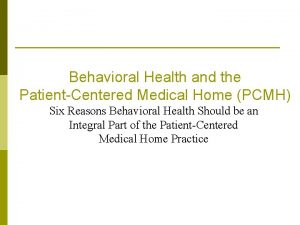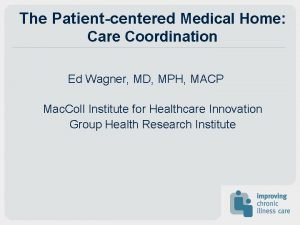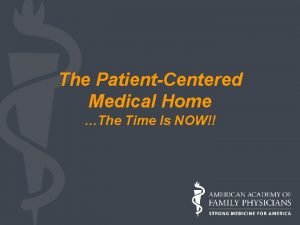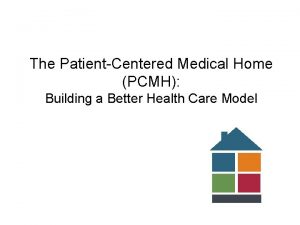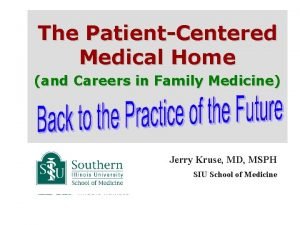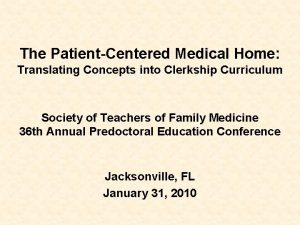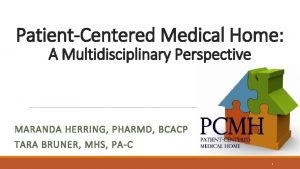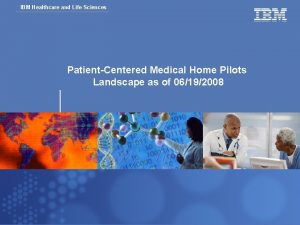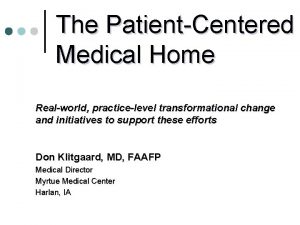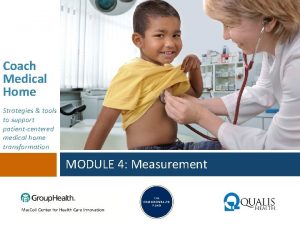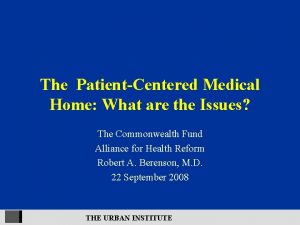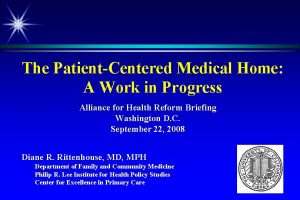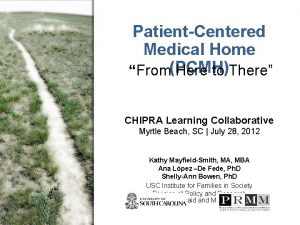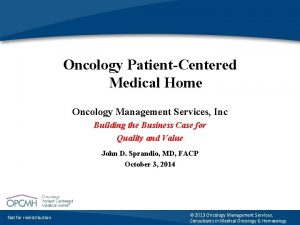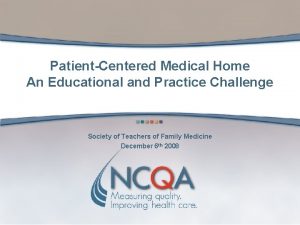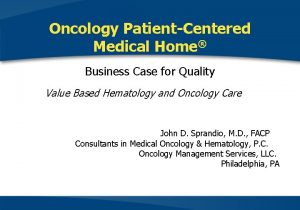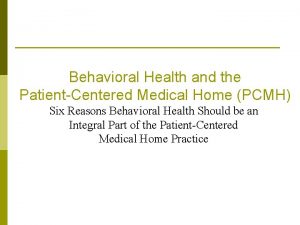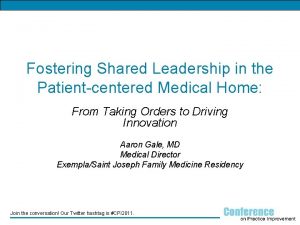A PatientCentered Medical Home Curriculum for Third Year







































- Slides: 39

A Patient-Centered Medical Home Curriculum for Third. Year Medical Students Mariquita Belen, MD Janice Spalding, MD David Sperling, MD Anthony Tam January 30, 2015

Disclosures I, my spouse or any immediate family members do not have any relationships with any commercial interest organizations to disclose.

Objectives 1. To describe the Patient-Centered Medical Home Curriculum (PCMH) for third-year medical students at Northeast Ohio Medical University rotating in Aultman Family Medicine. 2. To discuss the importance of integrating quality improvement as a key component of PCMH during Family Medicine rotation. 3. To assess the applicability of this PCMH curriculum in their respective institutions.

PCMH Curriculum Overview After completing the course, M 3 students will be able to: • Understand Patient-Centered Medical Home (PCMH) • Recognize importance of team-based care • Value continuous improvement

Curricular Goals • Medical students will understand the concept and framework of PCMH • Recognize the importance of team-based care • Aim for excellence and continuous quality and practice improvement

Objectives • define PCMH in accordance with the AAFP definition • describe the PCMH components: Practice Organization, Quality Measures, Patient Experience, and Health Information Technology • design and implement a practice improvement or quality improvement project

Instructional Strategies/Implementation Plan Time Activity Resource Staff/Resident/ Faculty Involvement Week 1, Day 1 Asynchronous AM learning “Introduction to PCMH” video Week 1 Day 2 1 hour Small group discussion Weeks 1 -2 Self-directed Learning PCMH at Faculty. Aultman Family PCMH Medicine Champion presentation Fundamentals of Improvement Modules from IHI

Instructional Strategies/Implementation Plan Time Activity Resource Staff/Resident/ Faculty Involvement Week 1, Day 1 Asynchronous AM learning “Introduction to PCMH” video Week 1 Day 2 1 hour Small group discussion Weeks 1 -2 Self-directed Learning PCMH at Faculty. Aultman Family PCMH Medicine Champion presentation Fundamentals of Improvement Modules from IHI

Instructional Strategies/Implementation Plan Time Activity Resource Staff/Resident/ Faculty Involvement Weeks 1 -2 hours, 2 sessions Shadow resident Experiential or nurse or front learning; identify office staff one area for improvement Resident or nurse or front office staff Last day of Week 2 1 hour Needs IHI Handbook. Assessment; Charter Form; Designing a plan PDSA Form Faculty Advisor

Instructional Strategies/Implementation Plan Time Activity Week 3, Day 1 Discuss 30 minutes implementation and data collection plan Resource Staff/Resident/F aculty Involvement IHI Handbook. PDSA Form Application of “Plan” in the PDSA cycle Faculty Advisor Week 3, Day 2 Orientation of Application of huddle staff, residents, “Do” in the faculty re: PDSA cycle Implementation /data collection Staff Residents faculty

Instructional Strategies/Implementation Plan Time Activity Weeks 3 -4 Implementation/ IHI Handbook. Data Collection PDSA Form; Application of “Do” in the PDSA cycle Analysis of Data IHI Handbook. PDSA Form; Application of “Study” in the PDSA cycle Week 5 30 minutes Resource Staff/Resident/ Faculty Involvement Staff Residents Faculty Advisor

Instructional Strategies/Implementation Plan Time Activity Resource Staff/Resident/ Faculty Involvement Week 6, Day 1 Discuss results; 30 minutes Preparation for Presentation of the project IHI Handbook. Practicum Summary Report Faculty Advisor Week 6 Noon Conference IHI Handbook. Practicum Summary Report Staff Residents Faculty Presentation of the Project max of 10 minutes

Resources Powerpoint slides Initial Cost $ 720 Succeeding Cost 0 Video Lecture 810 0 Faculty 280 $ 280 Conference Room 250 3 3 Web Hosting Total $2, 063 $ 533

Learner Assessment • Quiz • Conference Evaluation form • Personal reflection on “How quality improvement or practice improvement project will affect patients, staff, providers and healthcare system? ”

Evaluation • Students will evaluate the PCMH curriculum by completing an evaluation form. • Residents, faculty and staff will complete a post evaluation of satisfaction of the curriculum. • A cost/benefit analysis will be tracked and reported by the Clerkship Coordinator.



Purpose of the Study • To demonstrate that third-year medical students will have increase in knowledge about PCMH and QI after implementation of the PCMH curriculum.

Purpose of the Study • To demonstrate that third-year medical students will increase their competence to develop and implement a quality improvement project using Plan-Do-Study. Act (PDSA) cycle.

Purpose of the Study • To evaluate the effect of formal PCMH curriculum on the change in the personal perception of medical students’ knowledge, skills, attitude and experience related to PCMH and QI.

Methodology • Quasi-experimental study • Aultman Family Medicine (Intervention) and Summa Family Medicine (Control) from May 2015 to October 2015 • All third-year medical students rotating in Family Medicine

Mean change in knowledge score for QI and PCMH 3, 5 3 2, 5 2 Intervention (n=5) 1, 5 Control (n=6) 1 0, 5 0 -0, 5 PDSA PCMH Component

Mean Change in Knowledge Score for QI and PCMH Intervention (n=5) Control (n=6) Difference in Mean Change (95% CI) PDSA, mean 3. 2 0. 67 2. 53 (0. 20, 4. 87) PCMH Component, mean 0. 80 -0. 50 1. 30 (0. 15, 2. 45)

QI self-assessment change in knowledge, skills and attitude 2 1, 5 1 0, 5 0 -0, 5 Knowledg e Experienc e Develop Patient and Care Implemen t Intervention (n=5) Control (n=6) Residency Program

PCMH self-assessment change in knowledge and experience 1, 8 1, 6 1, 4 1, 2 Intervention (n=5) 1 Control (n=6) 0, 8 0, 6 0, 4 0, 2 0 Knowledge Experience

Conclusion • A structured PCMH curriculum integrated in the Family Medicine clerkship rotation improves: – the knowledge; – student-perceived skills; and – attitude especially in QI.

Conclusion • Empowering the students to recognize an area of need and having them apply the PDSA cycle made them more comfortable and willing to participate in QI projects. • This also improved their knowledge of and experience with PCMH.

Conclusion Successful implementation of innovative PCMH curricula is a key to preparing a workforce ready to practice in a new model of healthcare delivery. PCMH curriculum can enhance third-year medical student self -assessed knowledge of and attitudes toward PCMH. -Collins L, et al, 2014

Conclusion • The Future of Family Medicine report also recognized that the crucial characteristic of new model of care should be disseminated through curricula in family medicine residencies and clerkships. - Jortberg BT, et al, 2014

References 1. Al-Bawardy R, Blatt B, Al-Shohaib S, Simmens SJ. Cross-cultural comparison of the patient-centeredness of the hidden curriculum between a Saudi Arabian and 9 US medical schools. Med Educ Online. 2009; 14: 19. 2. Bansal A. Cultural competency training is a vehicle to promote patient-centred care. Clin Teach. 2010; 7(3): 225 -226. 3. Barnhart A, Lausen H, Smith T, Lopp L. Electronic health communication: an educational application for this principle of the Patient-centered Medical Home. Fam Med. 2010; 42(5): 322 -326. 4. Blanch-Hartigan D, Hall JA, Roter DL, Frankel RM. Gender bias in patients' perceptions of patient-centered behaviors. Patient Educ Couns. 2010; 80(3): 315 -320. 5. Bombeke K, Symons L, Debaene L, De Winter B, Schol S, Van Royen P. Help, I'm losing patient-centredness! Experiences of medical students and their teachers. Med Educ. 2010; 44(7): 662 -673.

References 6. Bower DJ, Young S, Larson G, et al. Characteristics of patient encounters that challenge medical students' provision of patient-centered care. Acad Med. 2009; 84(10 Suppl): S 74 -78. 7. D'Aquila M. How to integrate the PCMH concept. Fam Med. 2011; 43(10): 745. 8. David A, Baxley L. Education of students and residents in Patient Centered Medical Home (PCMH): preparing the way. Ann Fam Med. 2011; 9(3): 274 -275. 9. Dent MM, Mathis MW, Outland M, Thomas M, Industrious D. Chronic disease management: teaching medical students to incorporate community. Fam Med. 2010; 42(10): 736 -740. 10. Dudas RA, Lemerman H, Barone M, Serwint JR. PHACES (Photographs of Academic Clinicians and Their Educational Status): a tool to improve delivery of family -centered care. Acad Pediatr. 2010; 10(2): 138 -145.

References 11. Gorter JW, Visser-Meily A, Ketelaar M. The relevance of family-centred medicine and the implications for doctor education. Med Educ. 2010; 44(4): 332 -334. 12. Haidet P. Patient-centredness and its challenge of prevailing professional norms. Med Educ. 2010; 44(7): 643 -644. 13. Hammond M, Mc. Lean E. What parents and carers think medical students should be learning about communication with children and families. Patient Educ Couns. 2009; 76(3): 368 -375. 14. Hauer KE, Boscardin C, Gesundheit N, Nevins A, Srinivasan M, Fernandez A. Impact of student ethnicity and patient-centredness on communication skills performance. Med Educ. 2010; 44(7): 653 -661. 15. Heidelbaugh JJ. Teaching strategies behind the principles. Prim Care. 2012; 39(2): xiii-xiv.

References 16. Henschen BL, Garcia P, Jacobson B, et al. The patient centered medical home as curricular model: perceived impact of the "education-centered medical home". J Gen Intern Med. 2013; 28(8): 1105 -1109. 17. Illingworth R. What does 'patient-centred' mean in relation to the consultation? Clin Teach. 2010; 7(2): 116 -120. 18. Institute for Healthcare Improvement Open School Quality Improvement Practicum Handbook. Retrieved September 10, 2014 from http: //www. ihi. org/education/ihiopenschool/Courses/documents/practicum. Docume nts/learnerhandbook. pdf 19. Joo P, Younge R, Jones D, Hove J, Lin S, Burton W. Medical student awareness of the Patient-centered Medical Home. Fam Med. 2011; 43(10): 696 -701. 20. Jortberg BT, Fernald DH, Dickinson LM, et al. Curriculum redesign for teaching the PCMH in Colorado Family Medicine Residency programs. Fam Med. 2014; 46(1): 11 -18.

References 21. Jucks R, Paus E, Bromme R. Patients' medical knowledge and health counseling: what kind of information helps to make communication patient-centered? Patient Educ Couns. 2012; 88(2): 177 -183. 22. Kontos N, Querques J, Freudenreich O. Two's company, three hundred million's a crowd: balancing clinical integrity and population consciousness in medical education. Acad Med. 2011; 86(11): 1341. 23. Morrow CE, Reed VA, Eliassen MS, Imset I. Shared decision making: skill acquisition for year III medical students. Fam Med. 2011; 43(10): 721 -725. 24. Nielsen, M. Olayiwola, J. N. , Grundy, P. , Grumbach, K. (ed. ) Shaljian, M. The Patient-Centered Medical Home's Impact on Cost & Quality: An Annual Update of the Evidence, 2012 -2013. Patient-Centered Primary Care Collaborative (2014). 25. O'Neill SM, Henschen BL, Unger ED, et al. Educating future physicians to track health care quality: feasibility and perceived impact of a health care quality report card for medical students. Acad Med. 2013; 88(10): 1564 -1569.

References 26. Pelling S, Kalen A, Hammar M, Wahlstrom O. Preparation for becoming members of health care teams: findings from a 5 -year evaluation of a student interprofessional training ward. J Interprof Care. 2011; 25(5): 328 -332. 27. Saultz JW, O'Neill P, Gill JM, et al. Medical student exposure to components of the patient-centered medical home during required ambulatory clerkship rotations: implications for education. Acad Med. 2010; 85(6): 965 -973. 28. Scheffer C, Tausche D, Edelhauser F. "I wish I had a physician like that. . . "--the use of triangulation on the way towards a patient-centred medical education. Patient Educ Couns. 2011; 82(3): 465 -467. 29. Scott MA, Hitch B, Ray L, Colvin G. Integration of pharmacists into a patientcentered medical home. J Am Pharm Assoc (2003). 2011; 51(2): 161 -166. 30. Spitalnik DM, Coffield CN, Gabry K, White-Scott S. A lesson in humanism: educating medical students about family-centered care and developmental disabilities. MD Advis. 2012; 5(2): 32 -34.

References 31. Teherani A, Irby DM, Loeser H. Outcomes of different clerkship models: longitudinal integrated, hybrid, and block. Acad Med. 2013; 88(1): 35 -43. 32. Vaishnava P. PPQRST revisited. Acad Med. 2012; 87(4): 485. 33. Watkins RW. Partnering with universities and colleges to facilitate the PCMH process. An innovative plan to place healthcare management students into practices to promote healthcare transformation. J Med Pract Manage. 2012; 28(2): 134 -136. 34. Wilkerson L, Fung CC, May W, Elliott D. Assessing patient-centered care: one approach to health disparities education. J Gen Intern Med. 2010; 25 Suppl 2: S 86 -90. 35. Wilson AR, Fabri PJ, Wolfson J. Human error and patient safety: interdisciplinary course. Teach Learn Med. 2012; 24(1): 18 -25.

References 36. David A, Baxley L. Education of students and residents in Patient Centered Medical Home (PCMH): preparing the way. Ann Fam Med. 2011; 9(3): 274 -275. 37. Gould BE, Grey MR, Huntington CG, et al. Improving patient care outcomes by teaching quality improvement to medical students in community-based practices. Acad Med. 2002; 77(10): 1011 -1018. 38. Collins L, Sato R, La. Noue M, Michaluk L, Verma M. Impact of a patientcentered medical home clerkship curriculum. Fam Med. 2014; 46(6): 440 -446. 39. Jortberg BT, Fernald DH, Dickinson LM, et al. Curriculum redesign for teaching the PCMH in Colorado Family Medicine Residency programs. Fam Med. 2014; 46(1): 11 -18. 40. Kayingo G, Kidd VD, Warner ML. Patient-centered medical homes and physician assistant education: preparing the PA student for the practice of the future. J Physician Assist Educ. 2014; 25(4): 21 -28. 41. Djuricich AM. Curriculum continuous in quality improvement residents. for Department of Medicine and Pediatrics, Indiana University School of Medicine. CQI curriculum/Indiana University School of Medicine//Djuricich/Med. Ed Portal 2006.

Acknowledgement Janice Spalding, MD David Sperling, MD Anthony Tam Pat Franzen Karl Nelson, Ph. D Mike Hewitt Claire Bourguet, Ph. D Elliot Davidson, MD Katherine Sheridan, MD John Sutton, MD David Wakulchik, MD Roger Musa, MD Susan Labuda Schrop, Ph D Julie Stier Rienne Johnson, MLIS Elaine Ott Diana R. Dillon Elaine Guregian NEOMED Aultman Hospital Summa-Akron City Hospital

Please evaluate this presentation using the conference mobile app! Simply click on the "clipboard" icon on the presentation page.
 Mount and hume classification
Mount and hume classification Gj mount classification of caries
Gj mount classification of caries Third sunday of easter year c
Third sunday of easter year c Polytechnic education
Polytechnic education Last day of year 6 poem
Last day of year 6 poem Home care adalah
Home care adalah Perbedaan home care dan home visit
Perbedaan home care dan home visit South carolina mobile home parks for sale
South carolina mobile home parks for sale Plurals of flower
Plurals of flower Come home come home jesus is calling
Come home come home jesus is calling Oak springs rv park
Oak springs rv park Let's go to my house let's go today
Let's go to my house let's go today Arman home sweet home
Arman home sweet home She said that, home economics stands for the ideal home.
She said that, home economics stands for the ideal home. Home sweet home survive crash
Home sweet home survive crash Victorian f-10 curriculum
Victorian f-10 curriculum Victorian curriculum english
Victorian curriculum english Patient centered medical home conference
Patient centered medical home conference What is a medical foster home
What is a medical foster home Patient centered medical home
Patient centered medical home Medical foster home program
Medical foster home program Your medical home
Your medical home Harvard medical school curriculum
Harvard medical school curriculum Fspos vägledning för kontinuitetshantering
Fspos vägledning för kontinuitetshantering Novell typiska drag
Novell typiska drag Tack för att ni lyssnade bild
Tack för att ni lyssnade bild Ekologiskt fotavtryck
Ekologiskt fotavtryck Varför kallas perioden 1918-1939 för mellankrigstiden?
Varför kallas perioden 1918-1939 för mellankrigstiden? En lathund för arbete med kontinuitetshantering
En lathund för arbete med kontinuitetshantering Kassaregister ideell förening
Kassaregister ideell förening Tidbok
Tidbok Anatomi organ reproduksi
Anatomi organ reproduksi Densitet vatten
Densitet vatten Datorkunskap för nybörjare
Datorkunskap för nybörjare Tack för att ni lyssnade bild
Tack för att ni lyssnade bild Hur skriver man en debattartikel
Hur skriver man en debattartikel Delegerande ledarstil
Delegerande ledarstil Nyckelkompetenser för livslångt lärande
Nyckelkompetenser för livslångt lärande Påbyggnader för flakfordon
Påbyggnader för flakfordon Lufttryck formel
Lufttryck formel



